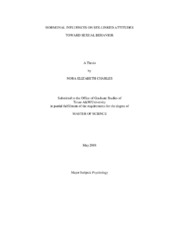| dc.description.abstract | Previous studies of non-human animals and humans with endocrine
abnormalities have demonstrated that higher prenatal androgen levels promote more
male-typical behavior, including cognitive abilities and sexual behavior. Research on
normal hormonal fluctuations (e.g. menstrual cycle studies) has shown additional effects
of circulating sex hormones in postnatal life on the expression of a number of sex-linked
cognitive and sexual behaviors. This research was designed to replicate previously
reported sex differences in a variety of domains and to extend prior findings of an
association between low (male-typical) 2nd to 4th digit (2D:4D) ratio, enhanced (maletypical)
mental rotation ability, and more liberal (male-typical) sexual attitudes and
behavior in women. This is also the first study to examine the effects of hormonal
factors and other sex-linked variables on sociosexuality in men. As part of this study,
participants (n = 127) completed a battery of gender role measures, sex-linked cognitive
tasks, and a sexual attitudes questionnaire. Prenatal androgen levels were indirectly
measured by means of the index to ring finger (2D:4D) ratio, and testosterone and
progesterone levels were obtained from saliva samples collected at each session from
participants who were not using hormonal contraceptives. Results replicate previously reported sex differences in sexual attitudes, sex-linked behaviors and
personality traits. More importantly, results provide the first evidence for both pre- and
postnatal contributions to sexual attitudes. Men with lower (more male-typical) 2D:4D
ratios reported less restricted (more male-typical) sexual attitudes, suggesting that
prenatal hormone levels may influence sexual attitudes in adulthood, at least in men.
Additionally, the tendency for women who were not using hormonal contraceptives to
report less restricted sexual attitudes during the mid-luteal phase of their cycle than
during the menstrual phase suggests that changes in circulating sex hormone levels in
adulthood, such as those during the menstrual cycle, may influence sexual attitudes in
women. | en |


